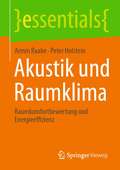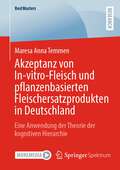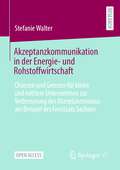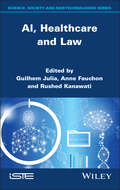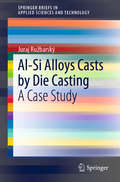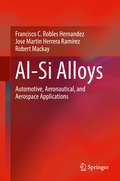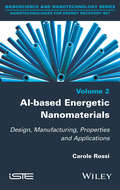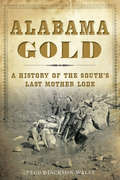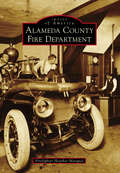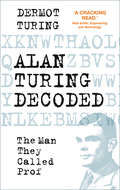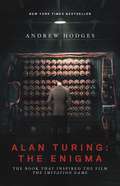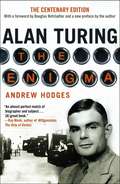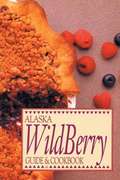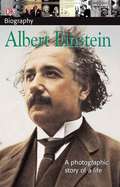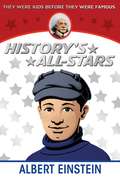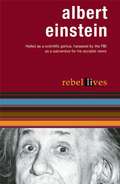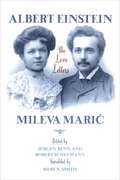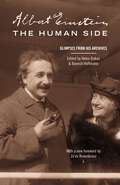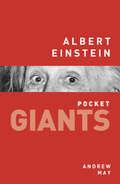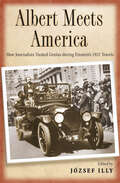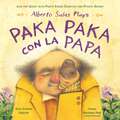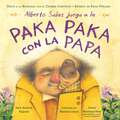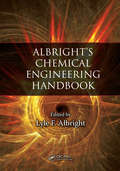- Table View
- List View
Akustik und Raumklima: Raumkomfortbewertung und Energieeffizienz (essentials)
by Armin Raabe Peter HolsteinObwohl in diesem essential akustische Messmethoden in Räumen und Gebäuden behandelt werden, ist hier Akustik nicht als Bauakustik zu verstehen. Zusätzlich zu herkömmlichen Methoden zur Bewertung des Innenraumklimas und für eine energieeffiziente Klimatisierung lassen sich mit akustischen Methoden Informationen gewinnen, die bei der Raumklimagestaltung von Nutzen sein können:- zur Analyse von Schallgeschwindigkeitsverteilungen als Informationsquelle über Temperatur- und Strömungsfelder in Räumen,- zur akustischen Detektion von Undichten zum Nachweis unerwünschter Be- bzw. Entlüftung und damit von Energieverlusten.Die Verfahren stammen zum Teil aus anderen Wissensgebieten, u.a. der Meteorologie, Tomografie oder der bildlichen Darstellung von Schallquellen. Damit können sie als Alternativen und Ergänzungen zu den herkömmlichen Methoden einer energieeffizienten Raumklimagestaltung verstanden werden.
Akzeptanz von In-vitro-Fleisch und pflanzenbasierten Fleischersatzprodukten in Deutschland: Eine Anwendung der Theorie der kognitiven Hierarchie (BestMasters)
by Maresa Anna TemmenMaresa Anna Temmen untersucht auf Grundlage der Theorie der kognitiven Hierarchie die Konsumbereitschaft für In-vitro-Fleisch und pflanzenbasierte Fleischersatzprodukte in Deutschland. Hierzu werden unter anderem ernährungspsychologische Einflussfaktoren genutzt, die sich auf moralische und ideologische Einstellungen zum Fleischkonsum beziehen. Die Ergebnisse der quantitativen Online-Fragebogenstudie zeigen, dass die Konsumbereitschaft für In-vitro-Fleisch und pflanzenbasierte Fleischersatzprodukte in der deutschen Bevölkerung relativ hoch ist und stützen die Theorie der kognitiven Hierarchie: Entsprechend können eine universalistisch geprägte Wertestruktur, eine geringe soziale Dominanzorientierung, eine geringe Ausprägung von Speziesismus und karnistischer Dominanz sowie eine geringe Unterstützung von Rechtfertigungsstrategien für den Konsum von Fleisch Gründe für eine hohe Konsumbereitschaft von In-vitro-Fleisch und pflanzenbasierten Fleischalternativen sein. Die Studie zeigt, dass tiefliegende Persönlichkeitsvariablen wie Werte und Wertorientierungen einen Einfluss auf spezifischere Einstellungen nehmen, die wiederum einen Einfluss auf die Konsumbereitschaft von Fleischalternativen haben.
Akzeptanzkommunikation in der Energie- und Rohstoffwirtschaft: Chancen und Grenzen für kleine und mittlere Unternehmen zur Verbesserung des Akzeptanzniveaus am Beispiel des Freistaats Sachsen
by Stefanie WalterDiese Open-Access-Publikation untersucht die Akzeptanz der sächsischen Bevölkerung gegenüber Energie- und Rohstoffvorhaben sowie die Eignung von Kommunikationsmaßnahmen zur Verbesserung des Akzeptanzniveaus. Die Bürger:innen werden erstmals repräsentativ zu ihrer (In-)Akzeptanz gegenüber Anlagearten befragt. Dabei wird nachgewiesen, dass die Akzeptanz bei lokalen Projekten immer geringer ist als soziopolitisch. Bei den erneuerbaren Energieumwandlungsanlagen ist die Akzeptanz gegenüber Wasserkraft- und Solaranlagen am höchsten, gegenüber Biomasseanlagen am geringsten. Fossile Energieumwandlungsanlagen sind weniger akzeptiert und Tage- und Untertagebaue werden am schlechtesten bewertet. Eine vergleichende Befragung der Unternehmensvertreter:innen des Energie- und Rohstoffsektors ergibt eine Dissonanz der von ihnen angenommenen zur erfassten (In-)Akzeptanz der Bevölkerung: Das Akzeptanzniveau ist unabhängig von der Art des Vorhabens geringer, als es die Unternehmensvertreter:innen annehmen.Die Erkenntnisse werden genutzt, um eine Webapplikation zu entwickeln, die es insbesondere kleinen und mittleren Unternehmen ermöglicht, zur Akzeptanzsteigerung geeignete Kommunikationsmaßnahmen auszuwählen.
Al, Healthcare and Law (ISTE Invoiced)
by Anne Fauchon Rushed Kanawati Guilhem JuliaIn a fully digitized world and hyper-connected society, artificial intelligence (AI) is developing more and more each day. In the aftermath of the Covid-19 pandemic, it seems appropriate to examine the real or imagined progress of AI in terms of human health. Like artificial intelligence, health is a field that involves a wide range of research disciplines. In order to better define and understand these social and technical developments, Al, Healthcare and Law brings together the thoughts and analyses of doctors, lawyers, economists and computer scientists. Through a wide range of original overviews of the issues involved, the book addresses questions such as the development of telemedicine, the use of medical data, the increased human perspective or medical ethics, and takes a multi-disciplinary and accessible approach to questioning the relationship between humans and computers, between the intimate and the machine.
Al-Si Alloys Casts by Die Casting: A Case Study (SpringerBriefs in Applied Sciences and Technology)
by Juraj RužbarskýThis book presents a study on the influence of selected technological parameters of die casting upon strength and use properties of Al-Si alloy casts produced in die casting. It contains a theoretical part describing the principles of casting technology, and its practical part revolves around the relationship between selected technological parameters of die casting in regard to strength and use properties represented by tensile strength and porosity of die casts.
Al-Si Alloys: Automotive, Aeronautical, And Aerospace Applications
by Francisco C. Robles-Hernandez Jose Martin Herrera Ramírez Robert MackayThis book details aluminum alloys with special focus on the aluminum silicon (Al‐Si) systems - that are the most abundant alloys second only to steel. The authors include a description of the manufacturing principles, thermodynamics, and other main characteristics of Al‐Si alloys. Principles of processing, testing, and in particular applications in the Automotive, Aeronautical and Aerospace fields are addressed.
Al-based Energetic Nano Materials
by Carole RossiOver the past two decades, the rapid development of nanochemistry and nanotechnology has allowed the synthesis of various materials and oxides in the form of nanopowders making it possible to produce new energetic compositions and nanomaterials. This book has a bottom-up structure, from nanomaterials synthesis to the application fields. Starting from aluminum nanoparticles synthesis for fuel application, it proposes a detailed state-of-the art of the different methods of preparation of aluminum-based reactive nanomaterials. It describes the techniques developed for their characterization and, when available, a description of the fundamental mechanisms responsible for their ignition and combustion. This book also presents the possibilities and limitations of different energetic nanomaterials and related structures as well as the analysis of their chemical and thermal properties. The whole is rounded off with a look at the performances of reactive materials in terms of heat of reaction and reactivity mainly characterized as the self-sustained combustion velocity. The book ends up with a description of current reactive nanomaterials applications underlying the promising integration of aluminum-based reactive nanomaterial into micro electromechanical systems.
Alabama Gold: A History of the South’s Last Mother Lode
by Peggy Jackson WallsGold rushes in Cleburne and Tallapoosa Counties attracted thousands of miners years before California's famous strike. In 1936, production at the Hog Mountain mine caused Alabama to be recognized as the top producer in the Appalachian states. In Hog Mountain's heyday, a local German settler discovered the precious metal while digging a wine cellar. In Log Pit, unscrupulous speculators "shot" ore into rock crevices and "salted" nuggets on land to enhance its sale value. A Cleburne County miner cleaned over eleven pounds of gold and was killed in a "free fight" all in one day. Join author Peggy Jackson Walls as she traces a century of gold mining in Alabama.
Alameda County Fire Department (Images of America)
by Firefighter Heather MarquesAlameda County spans from the shores of the San Francisco Bay to the golden inland hills. Alameda County Fire Department (ACFD) is comprised of multiple consolidated agencies that began joining forces and sharing resources in 1993. Protecting unincorporated county land as well as Ashland, Cherryland, San Lorenzo, Castro Valley, San Leandro, Dublin, Union City, Newark, Emeryville, and the National Laboratories at Livermore and Berkeley, ACFD serves over 500 square miles and 330,000 citizens. This legacy stretches back 140 years, recalling the shared experiences of bucket brigades, teams of horses pulling steam-engine pumpers down muddy roads, the advent of motorized apparatus, and the days when school boys would be pulled from class to ride tailboard to fight blazes in the hills. These agencies have sent soldiers to two world wars, survived massive earthquakes, fought catastrophic wildfires, and touched the lives of Bay Area citizens for over a century. The ACFD is the sum of its many unique parts, which together form a premier, all-risk fire department.
Alan M. Turing
by Sara TuringTuring's reputation has grown, as his contributions to logic, mathematics, computing, and artificial intelligence have become better appreciated. This republication of his mother's biography is enriched by a never-before-published memoir by Alan's older brother.
Alan Turing Decoded: The Man They Called Prof
by Dermot Turing‘A cracking read. ’Nick Smith, Engineering and TechnologyAlan Turing was an extraordinary man who crammed into his 42 years the careers of mathematician, codebreaker, computer scientist and biologist. He is widely regarded as a war hero grossly mistreated by his unappreciative country, and it has become hard to disentangle the real man from the story. It is easy to cast him as a misfit, the stereotypical professor. But actually Alan Turing was never a professor, and his nickname ‘Prof’ was given by his codebreaking friends at Bletchley Park. Now Dermot Turing has taken a fresh look at the influences on his uncle’s life and creativity, and the creation of a legend. He discloses the real character behind the cipher-text, answering questions that help the man emerge from his legacy: how did Alan’s childhood experiences influence him? How did his creative ideas evolve? Was he really a solitary genius? What was his wartime work after 1942, and what of the Enigma story? What is the truth about the conviction for gross indecency, and did he commit suicide? In Alan Turing Decoded, Dermot’s vibrant and entertaining approach to the life and work of a true genius makes this a fascinating and authoritative read.
Alan Turing: The Book That Inspired the Film The Imitation Game - Updated Edition
by Andrew HodgesA NEW YORK TIMES BESTSELLERThe official book behind the Academy Award-winning film The Imitation Game, starring Benedict Cumberbatch and Keira KnightleyIt is only a slight exaggeration to say that the British mathematician Alan Turing (1912–1954) saved the Allies from the Nazis, invented the computer and artificial intelligence, and anticipated gay liberation by decades—all before his suicide at age forty-one. This New York Times bestselling biography of the founder of computer science, with a new preface by the author that addresses Turing&’s royal pardon in 2013, is the definitive account of an extraordinary mind and life.Capturing both the inner and outer drama of Turing&’s life, Andrew Hodges tells how Turing&’s revolutionary idea of 1936—the concept of a universal machine—laid the foundation for the modern computer and how Turing brought the idea to practical realization in 1945 with his electronic design. The book also tells how this work was directly related to Turing&’s leading role in breaking the German Enigma ciphers during World War II, a scientific triumph that was critical to Allied victory in the Atlantic. At the same time, this is the tragic account of a man who, despite his wartime service, was eventually arrested, stripped of his security clearance, and forced to undergo a humiliating treatment program—all for trying to live honestly in a society that defined homosexuality as a crime.The inspiration for a major motion picture starring Benedict Cumberbatch and Keira Knightley, Alan Turing: The Enigma is a gripping story of mathematics, computers, cryptography, and homosexual persecution.
Alan Turing: The Enigma (The Centenary Edition)
by Andrew HodgesIt is only a slight exaggeration to say that the British mathematician Alan Turing (1912-1954) saved the Allies from the Nazis, invented the computer and artificial intelligence, and anticipated gay liberation by decades--all before his suicide at age forty-one. This classic biography of the founder of computer science, reissued on the centenary of his birth with a substantial new preface by the author, is the definitive account of an extraordinary mind and life. A gripping story of mathematics, computers, cryptography, and homosexual persecution, Andrew Hodges's acclaimed book captures both the inner and outer drama of Turing's life. Hodges tells how Turing's revolutionary idea of 1936--the concept of a universal machine--laid the foundation for the modern computer and how Turing brought the idea to practical realization in 1945 with his electronic design. The book also tells how this work was directly related to Turing's leading role in breaking the German Enigma ciphers during World War II, a scientific triumph that was critical to Allied victory in the Atlantic. At the same time, this is the tragic story of a man who, despite his wartime service, was eventually arrested, stripped of his security clearance, and forced to undergo a humiliating treatment program--all for trying to live honestly in a society that defined homosexuality as a crime.
Alaska Wild Berry Guide And Cookbook
by Editors of Alaska MagazineA discription of and recipes for nearly 50 wild berries that grow in Alaska.
Albert Einstein
by Frieda WishinskyDKY's acclaimed DK Biography series tackles two of history's most colorful figures in Harry Houdini and Albert Einstein. Perfect for book reports or summer reading, the DK Biography series brings a new clarity and narrative voice to history's most colorful figures.
Albert Einstein
by Marie Hammontree Robert DoremusBefore Albert Einstein was an internationally renowned genius, he was a kid--learn all about his childhood and what makes him an all-star in American history!Albert Einstein is a household name synonymous with genius around the world. His work unlocked mysteries of the universe and also impacted everyday conveniences like remote controls and televisions. And while most are familiar with Einstein's adult wisdom (and wild hair), do you know what he was like as a child? From his passion for music--he played both the violin and the piano--to his early curiosity for understanding the mysteries of science, in this narrative biography you'll learn all about Albert Einstein's childhood and the influences that shaped the life of a remarkable man.
Albert Einstein (Rebel Lives)
by Albert Einstein Tom KeebleEinstein as an absent-minded genius with his head in the clouds is a far cry from the real picture. A man deeply interested in social issues, Einstein felt it was his duty to use his fame and intellect to advance the cause of social justice.
Albert Einstein, Mileva Maric: The Love Letters
by Albert EinsteinIn 1903, despite the vehement objections of his parents, Albert Einstein married Mileva Maric, the companion, colleague, and confidante whose influence on his most creative years has given rise to much speculation. Beginning in 1897, after Einstein and Maric met as students at the Swiss Federal Polytechnic, and ending shortly after their marriage, these fifty-four love letters offer a rare glimpse into Einstein's relationship with his first wife while shedding light on his intellectual development in the period before the annus mirabilis of 1905. Unlike the picture of Einstein the lone, isolated thinker of Princeton, he appears here both as the burgeoning enfant terrible of science and as an amorous young man beset, along with his fiance, by financial and personal struggles--among them the illegitimate birth of their daughter, whose existence is known only by these letters. Describing his conflicts with professors and other scientists, his arguments with his mother over Maric, and his difficulty obtaining an academic position after graduation, the letters enable us to reconstruct the youthful Einstein with an unprecedented immediacy. His love for Maric, whom he describes as "a creature who is my equal, and who is as strong and independent as I am," brings forth his serious as well as playful, often theatrical nature. After their marriage, however, Maric becomes less his intellectual companion, and, failing to acquire a teaching certificate, she subordinates her professional goals to his. In the final letters Einstein has obtained a position at the Swiss Patent Office and mentions their daughter one last time to his wife in Hungary, where she is assumed to have placed the girl in the care of relatives. Informative, entertaining, and often very moving, this collection of letters captures for scientists and general readers alike a little known yet crucial period in Einstein's life.
Albert Einstein, The Human Side: Glimpses from His Archives
by Albert EinsteinModesty, humor, compassion, and wisdom are the traits most evident in this illuminating selection of personal papers from the Albert Einstein Archives. The illustrious physicist wrote as thoughtfully to an Ohio fifth-grader, distressed by her discovery that scientists classify humans as animals, as to a Colorado banker who asked whether Einstein believed in a personal God. Witty rhymes, an exchange with Queen Elizabeth of Belgium about fine music, and expressions of his devotion to Zionism are but some of the highlights found in this warm and enriching book.
Albert Einstein: pocket GIANTS
by Andrew MayEveryone has heard of Albert Einstein and everyone knows that he was a genius. Yet only a few people understand his work. In fact, he was just one of many brilliant scientists grappling with the deepest problems of theoretical physics during the first half of the twentieth century. He may not have been the most important or influential of them – the point is arguable – but there is no doubt he was the most revolutionary. Almost single-handed, he transformed the way the world thinks about light, matter, space and time.In the sixty years since his death Einstein has become a legend. The profound obscurity of his theories has contributed to this, as has his archetypal “mad scientist” appearance. His philosophical and political utterances – both real and imagined – are regularly used to clinch arguments online or in the pub. So how can a modern reader separate myth from reality? This short book attempts to do just that!
Albert Meets America: How Journalists Treated Genius during Einstein's 1921 Travels
by József IllyIn 1919, newspaper headlines said that a British expedition had confirmed Einstein's general theory of relativity. The news stirred the public imagination on both sides of the Atlantic and thrust the scientist into the spotlight of fame. Two years later, Chaim Weizmann led a fund-raising mission to the United States and invited Einstein to join it. The mission traveled to New York, Boston, Chicago, Cleveland, Philadelphia, and Hartford to campaign for public awareness and support of the Hebrew University of Jerusalem. This brought Einstein within the grasp of the American media. His lectures delivered in New York, Princeton, and Chicago, and comments on the Jewish presence in Palestine, made Einstein, on his first trip to America, one of the first media stars. In Albert Meets America, József Illy presents a fascinating compilation of media stories of Einstein’s tour—which cover his science, his Zionism, and the anti-Semitism he encountered. As we travel with Einstein, from headline to headline, we experience his emotional connection with American Jews and his frustration at becoming world famous even though his theories were not truly understood. This exciting collection gives readers an intimate glimpse into the life of one of the world’s first modern celebrities and a unique understanding of the media's power over both its subject and its audience.
Albert Meets America: How Journalists Treated Genius during Einstein's 1921 Travels
by József IllyThis volume of news articles from Einstein’s first trip to America explores his rise a public figure and the creation of his celebrity persona.When a British expedition confirmed Albert Einstein’s general theory of relativity in 1919, the news catapulted the German physicist to global fame. Two years later, he joined a fund-raising tour through the United States—a country he’d never seen before—gathering support for the Hebrew University of Jerusalem. His lectures in New York, Princeton, and Chicago, and comments on the Jewish presence in Palestine, made Einstein one of the first media stars. In Albert Meets America, József Illy presents a fascinating compilation of media stories written during Einstein’s trip that cover his science, his Zionism, and the anti-Semitism he encountered. Traveling with Einstein from headline to headline, readers experience his emotional connection with American Jews and his frustration at becoming world famous even though his theories were not truly understood.This collection gives readers an intimate glimpse into the life of one of the world’s first modern celebrities and a unique understanding of the media’s power over both its subject and its audience.
Alberto Salas Plays Paka Paka con la Papa: Join the Quest with Peru's Famed Scientist and Potato Expert
by Sara Andrea FajardoWhat can a potato do? To Peruvian scientist Alberto Salas, they have the power to change the world. Go on the hunt with Alberto for for wild potatoes before they go extinct in this playful picture book biography, gorgeously illustrated by Caldecott-honoree Juana Martinez-Neal.High up in the Andes mountains of Peru, agricultural scientist Alberto Salas is on a quest. A quest... for potatoes.Up and down the Andes mountains he goes, playing an epic game of paka paka con la papa, potato hide and seek. These potatoes are special: they have the power to feed the world. Alberto doesn't have a second to waste. The climate is changing and Alberto must find each and every one to save them before they go extinct.The game is on!Alberto races and peers and prods. Drives and trods and climbs. Will he find the potato he seeks? Will he win the game of paka paka con la papa?Author Sara Andrea Fajardo’s spirited biography about “the godfather of potatoes” is paired with lush art by Caldecott-honoree Juana Martinez-Neal to capture how celebrated scientist Alberto Salas brings joy, curiosity, and fun to his very important, life-changing work.
Alberto Salas juega a la paka paka con la papa [Spanish edition]: Únete a la búsqueda con el célebre científico y experto en papas peruano
by Sara Andrea FajardoEsta biografía ilustrada y oda a la conservación y ciencia acompaña al agrónomo peruano Alberto Salas en su búsqueda de papas silvestres antes de que se extingan, con ilustraciones de la ganadora de un Caldecott Honor, Juana Martínez-Neal. Muy alto en la cordillera de los Andes en Perú, el ingeniero agrícola Alberto Salas anda en una búsqueda. En búsqueda… de papas.Arriba y abajo de las montañas va, jugando un juego épico de paka paka con la papa, a las escondidas con la papa. Estos tubérculos son especiales: tienen el poder de alimentar y salvar al mundo.Alberto no tiene tiempo que perder. El clima está cambiando en los Andes y él debe encontrar y rescatar cada una de las variedades de papa antes de que se extingan.¡El juego ya empezó!Alberto corre, busca detenidamente y escarba. Maneja y camina y trepa. ¿Encontrará la papa que busca? ¿Podrá ganar este juego de paka paka con la papa?En su debut como autora con esta energética biografía sobre el “padrino de las papas”, Sara A. Fajardo une fuerzas con el rico y lúdico arte de la ilustradora galardonada con el premio Caldecott, Juana Martinez Neal, capturando cómo el celebrado agrónomo Alberto Salas realiza su imprescindible trabajo con deleite, curiosidad y regocijo.
Albright's Chemical Engineering Handbook
by Lyle F. AlbrightTaking greater advantage of powerful computing capabilities over the last several years, the development of fundamental information and new models has led to major advances in nearly every aspect of chemical engineering. Albright's Chemical Engineering Handbook represents a reliable source of updated methods, applications, and fundamental co
